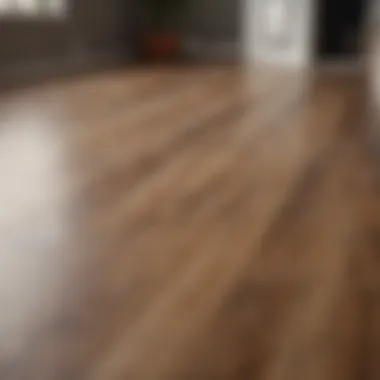Can You Use Dawn Dish Soap on Laminate Floors?


Intro
Cleaning laminate floors can be a dilemma, particularly when determining which products are safe and effective. Many homeowners wonder if they can use Dawn dish soap on their laminate surfaces. This question is not trivial, as using inappropriate cleaning agents may lead to long-term damage. Understanding the characteristics of laminate flooring and the properties of Dawn dish soap is crucial for making informed cleaning choices.
Dawn dish soap is known for its grease-fighting abilities, often praised for its effectiveness in dishwashing. However, its suitability as a cleaning solution for laminate floors is less clear. Laminate flooring is constructed with a unique composite material that can react adversely to harsh chemicals or excessive moisture. Therefore, before using Dawn, it is essential to dissect the interaction between the soap and the laminate's surface.
In this analysis, we will delve into the effectiveness of Dawn dish soap as a cleaning agent for laminate floors. We will explore the chemical composition of the soap, potential risks, and alternative cleaning solutions that are safer and just as effective. By the end of this article, readers will be equipped with the knowledge necessary to maintain their laminate floors thoughtfully and effectively.
Understanding Laminate Flooring
Understanding laminate flooring is crucial when discussing its maintenance and cleaning requirements. This section explores what laminate flooring is and its characteristics, advantages, and limitations. Readers will gain insight into why particular cleaning products might be more or less suitable.
What is Laminate Flooring?
Laminate flooring is a multi-layer synthetic flooring product. It is designed to mimic the appearance of natural wood or stone while offering added durability and ease of installation. Typically, it consists of a core layer made from high-density fiberboard, a photographic layer that replicates wood or stone, and a protective overlay. This design allows for a wide variety of styles and finishes, making it appealing to many homeowners and designers.
Key Characteristics of Laminate Flooring
Laminate flooring is known for its resilience and adaptability. Some key characteristics include:
- Durability: It is resistant to scratches, moisture, and stains, making it ideal for high-traffic areas.
- Variety of Designs: The photorealistic layer allows for numerous visual options, from oak to slate.
- Easy Installation: Many laminate products feature a click-lock design, which simplifies the installation process for DIY enthusiasts.
- Maintenance: Laminate is generally easy to clean with regular upkeep, requiring no waxing or additional treatments.
- Affordability: Compared to hardwood, laminate flooring is often less expensive, appealing to budget-conscious homeowners.
Advantages of Laminate Flooring
There are significant benefits to choosing laminate flooring as a surface option in your home:
- Cost-Effective: Laminate tends to be more affordable than natural timber or stone materials.
- Resistant to Wear: Its protective layer enables it to withstand everyday wear and tear. This feature ensures the floor retains its look longer than traditional hardwood.
- Variety of Styles: With so many looks available, homeowners can tailor their spaces easily without compromising on design.
- Environmentally Friendly: Many laminate products are made from recycled materials, promoting sustainability.
Limitations of Laminate Flooring
Though laminate flooring has many advantages, some limitations must be acknowledged:
- Susceptibility to Moisture: While some versions are moisture-resistant, laminate can warp if exposed to excessive water.
- Life Span: It's generally less durable over the long term compared to solid wood flooring.
- Sound Quality: Laminate can produce more noise underfoot compared to carpet or hardwood, which may be a concern in certain settings.
- Not Repairable: If a section is damaged, complete replacement may be necessary since it cannot be sanded or refinished like hardwood.
Understanding these elements forms the foundation for making informed decisions about cleaning and maintaining laminate flooring.
Ingredient Analysis of Dawn Dish Soap
Analyzing the ingredients of Dawn dish soap is essential for understanding its potential implications on laminate floors. This section delves into the makeup of the soap, its cleaning mechanisms, the benefits it may provide, and the risks that could arise from its use on delicate surfaces like laminate.


Composition of Dawn Dish Soap
Dawn dish soap is primarily composed of surfactants, which are agents that reduce the surface tension of water. These surfactants enable the soap to break up grease and facilitate the removal of particles from surfaces. In addition, Dawn contains various cleaning agents, fragrances, and preservatives that enhance its effectiveness. The primary surfactants include sodium lauryl sulfate and sodium laureth sulfate, which are known for their ability to produce lather and clean effectively. Understanding this composition helps users determine whether it is suitable for cleaning laminate flooring without causing damage.
Cleaning Mechanism of Dish Soap
The cleaning mechanism of Dawn dish soap hinges on its surfactants. When mixed with water, these surfactants create micelles, tiny clusters that surround grease and dirt. The soap molecules attach to the grime, allowing them to be lifted away from the surface. This property makes Dawn effective for kitchenware and other surfaces, but its applicability on laminate flooring can depend on dilution, application technique, and the specific type of stain.
Benefits of Using Dawn Dish Soap
Dawn dish soap offers several notable benefits:
- Effective Stain Removal: It is designed to combat tough grease, which may also assist in removing stubborn stains on laminate floors.
- Versatile Usage: Beyond dishwashing, it can be adapted for multiple cleaning tasks around the home.
- Easily Available: It is a widely used product, easily accessible in most grocery stores.
- Cost-Effective: Compared to specialized floor cleaners, it tends to be more affordable.
Potential Risks Involved
While there are benefits, some risks must be considered:
- Residue Build-Up: If not rinsed properly, the soap can leave a residue that makes floors appear dull.
- Surface Deterioration: Prolonged use or high concentrations of the soap can damage the finish of laminate flooring.
- Chemical Sensitivity: Individuals with sensitivities may react negatively to ingredients in the soap, leading to potential health concerns.
Using Dawn dish soap can be beneficial, but it also carries risks that should not be overlooked when cleaning laminate floors.
Evaluating Dawn Dish Soap for Laminate Floors
In the context of maintaining laminate floors, evaluating the suitability of Dawn dish soap as a cleaning agent is crucial. Laminate flooring is a popular choice due to its aesthetic appeal and durability. However, incorrect cleaning methods can lead to degradation over time. Thus, an assessment of cleaning products like Dawn becomes essential. This consideration involves understanding compatibility, effectiveness against common stains, and the overall impact on the floor’s finish and longevity.
Compatibility with Laminate Surfaces
Dawn dish soap is primarily designed for cleaning dishes and kitchen utensils, yet its compatibility with laminate surfaces merits examination. Laminate flooring comprises multiple layers, including a core layer made of high-density fiberboard, a design layer, and a protective coating. Because of this construction, it can be susceptible to damage from harsh chemicals or abrasive substances.
Most dish soaps, including Dawn, are formulated to be gentle on surfaces, making them suitable for routine cleaning. However, it is important to dilute the soap with water before application to avoid potential issues such as streaking or residue accumulation.
Effectiveness Against Stains and Dirt
Another significant aspect to consider is how effective Dawn dish soap is against stains and dirt on laminate floors. The cleaning mechanism of Dawn focuses on breaking down grease and food particles, which can be beneficial in tackling common household stains.
Many users report positive results when using diluted Dawn soap to clean sticky or greasy marks on their floors. Its surfactant properties allow it to lift dirt from surfaces without excessive scrubbing. However, it is advisable to test a small, inconspicuous area first. Improper use may lead to undesirable results, such as dulling the floor’s sheen.
Impact on Finish and Longevity


The impact of using Dawn dish soap on the long-term integrity of laminate flooring is worth careful consideration. While occasional use of diluted Dawn may not pose immediate harm, regular cleaning with any dish soap has the potential to wear down the protective finish on laminate over time.
To maintain the floor’s luster, it is crucial to balance the cleaning frequency with the right product choice. Choosing a designated laminate floor cleaner may ultimately provide better results by preserving the finish, while avoiding any risks associated with using dish soaps regularly.
"Using the right cleaning products prolongs the life of your laminate. Make informed choices!"
Proper Cleaning Techniques for Laminate Floors
Implementing proper cleaning techniques is essential for maintaining laminate floors. Unlike hardwood, laminate can be sensitive to certain cleaning methods and products. Understanding how to clean effectively can prolong the lifespan of these surfaces, protecting them from wear and tear.
Preparation for Cleaning
Before starting the cleaning process, it is important to prepare accordingly.
- Clear the Area: Remove all furniture and items from the floor. This allows for safe and thorough cleaning. It also helps prevent damage to your belongings.
- Dusting: Use a dry mop or vacuum equipped with a soft brush to eliminate dust and debris. This step avoids scratching the surface while cleaning.
- Inspect Floors: Check for any stains or areas needing special attention. This will guide your approach and ensure that no issues are overlooked.
Dilution Ratios for Effective Cleaning
Using the correct dilution ratio is critical when mixing Dawn dish soap with water. An overly concentrated solution can result in a sticky residue or potential damage to the laminate surface.
- Basic Ratio: Generally, a mixture of one squeeze of Dawn for every gallon of warm water is effective.
- Test First: Always conduct a spot test in an inconspicuous area to check for adverse reactions. This helps ensure that the soap will not affect the laminate’s finish.
Recommended Cleaning Methods
There are various methods to clean laminate floors properly. Choosing the right one impacts the effectiveness and safety of the process.
- Mopping: Use a damp mop instead of soaking the floor. Excess water can seep into seams and lead to swelling.
- Microfiber Cloths: These are preferable for spot cleaning or maintaining shine without damaging the surface.
- Avoid Harsh Chemicals: Stay clear of strong chemical cleaners. They can cause discoloration or deterioration of the laminate.
In summary, proper preparation, correct dilution ratios, and appropriate cleaning methods are essential when maintaining laminate floors. Following these guidelines can help keep the floors looking pristine and greatly extend their lifespan.
Alternatives to Dawn Dish Soap
When it comes to cleaning laminate floors, considering alternatives to Dawn dish soap is essential. While Dawn is a popular choice, it is not the only option available. Exploring other cleaning solutions allows homeowners to find products that better suit their needs while ensuring the integrity of laminate surfaces. It is important to identify the specific cleaning requirements, effectiveness, and safety of alternatives to tailor the cleaning process accordingly.
Commercial Cleaning Solutions
Commercial cleaning solutions provide users with several options when cleaning laminate floors. These products are specifically formulated for laminate surfaces, ensuring they do not cause harm or dull the finish. Common choices include:
- Bona Hard-Surface Floor Cleaner: This formula is designed for hard surfaces and provides a streak-free finish. It is safe for everyday use and helps maintain the shine of the laminate.
- Pledge Clean & Shine: This cleaner is suitable for various surfaces, including laminate. It leaves a protective layer that resists dust and fingerprints, making it easier to clean in the future.
- Zep Hardwood and Laminate Floor Cleaner: As a non-toxic option, Zep delivers effective cleaning without damaging the laminate surface. It evaporates quickly and does not leave a residue, promoting a clean, shiny appearance.


Commercial solutions often come with clear instructions on usage and dilution ratios, making them convenient to use. However, it is essential to choose products specifically labeled as safe for laminate floors. Always check the ingredients and ensure they do not contain harsh chemicals that might harm the floor's finish.
Homemade Cleaning Solutions
For those who prefer a more natural approach, homemade cleaning solutions can be both effective and economical. Using common household items, it is possible to create a cleaning solution that safely cleans laminate floors. Here are a few popular recipes:
- Vinegar and Water Solution: Mix one cup of white vinegar with one gallon of warm water. This solution effectively removes dirt and grime without harsh chemicals. However, use it sparingly, as excessive vinegar can dull finishes over time.
- Dish Soap and Water Solution: Combine a few drops of a gentle dish soap, such as Dawn, with a gallon of water. This mixture can effectively tackle sticky residues and stains without damaging the laminate surface.
- Essential Oil Blend: Adding a few drops of essential oils such as tea tree or lavender to a vinegar and water solution not only adds a pleasant fragrance but also enhances the antibacterial properties of the mixture.
Using homemade solutions allows homeowners to have control over the ingredients used, reducing exposure to synthetic chemicals. Nonetheless, it is vital to test any homemade cleaner in a small area before widespread application to prevent any adverse reaction on the laminate finish.
Maintenance Tips for Laminate Floors
Laminate floors are known for their durability and aesthetic appeal. However, maintaining their condition requires a systematic approach. Proper care helps in preserving the surface, ensuring longevity, and preventing unnecessary repair costs. Below are some key insights into effective maintenance of laminate flooring that can make a significant difference over time.
Regular Cleaning Schedule
Establishing a regular cleaning schedule is essential for laminate floor maintenance. This practice helps to eliminate dirt and prevent buildup from grime and stains, which can dull the appearance of your flooring. Here are some features of a cleaning routine:
- Frequency: Depending on foot traffic, a weekly cleaning might be effective for most homes. High-traffic areas may need more frequent attention.
- Methods: Utilize a dry mop or vacuum regularly to remove dust and debris. It is better to avoid a broom, as it can scratch the surface.
- Deep Cleaning: Every few months, perform a thorough cleaning with a damp mop and a suitable laminate cleaner.
This approach not only helps in maintaining visual appeal but also enhances the longevity of the flooring material.
Preventative Measures to Avoid Damage
Preventative measures are crucial in avoiding irreversible damage to laminate flooring. Here are some recommended practices:
- Area Rugs: Placing area rugs in high-traffic zones can absorb impact and reduce wear from everyday activities.
- Furniture Pads: Using furniture pads under heavy items can prevent scratches and dents when moved.
- Humidity Control: Monitor indoor humidity levels. Laminate can swell or warp in extreme conditions. Maintain a stable and moderate environment.
- Avoiding Moisture: Spills should be cleaned immediately to prevent water from seeping into seams.
The implementation of these methods not only preserves the surface but also maintains the integrity of the laminate flooring over time.
Taking a proactive approach to cleaning and maintenance can significantly increase the lifespan of your laminate floors, saving you expenses in the long run.
End and Recommendations
In closing, the analysis of using Dawn dish soap on laminate floors yields important insights for homeowners looking to maintain their flooring effectively. This approach emphasizes that, while Dawn dish soap can serve as an effective cleaner, it is imperative to consider the unique characteristics of laminate surfaces. Proper understanding and application can lead to a cleaner floor without compromising its finish and longevity.
Final Thoughts on Using Dawn Dish Soap
Dawn dish soap is known for its grease-fighting capabilities, which can be beneficial for certain cleaning tasks. However, when used on laminate flooring, caution is necessary. Over time, excessive use or improper dilution may damage the protective finish, leading to fading or delamination. Therefore, moderation in cleaning frequency with this product is recommended. Additionally, it is a good practice to test a small area before broad application to ensure no adverse reactions occur.
"Using household cleaning products without knowledge can lead to unintended damage, especially on laminate surfaces. Always test before applying extensively."
Best Practices for Cleaning Laminate Floors
To preserve the beauty and integrity of laminate floors, here are some best practices to consider while cleaning:
- Choose the Right Cleaner:
Opt for a cleaner specifically designed for laminate surfaces for routine cleaning. - Dilute Properly:
If using Dawn dish soap, ensure proper dilution with water. A common ratio is one tablespoon of soap per gallon of water. - Use a Microfiber Cloth or Mop:
Avoid soaking the floors; use a damp cloth or mop. This reduces moisture exposure that could seep between seams. - Sweep or Vacuum Regularly:
Keep dirt and debris at bay by sweeping or vacuuming before mopping. This prevents scratches. - Spot Clean Stains Immediately:
Address spills and stains right away to avoid buildup. Make sure the cleaning mixture is safe for laminate.
By adhering to these recommendations and understanding both the benefits and risks associated with Dawn dish soap, users can maintain their laminate floors effectively. Keeping the balance between cleanliness and care will serve to ensure that these surfaces remain both aesthetically pleasing and functional over time.







